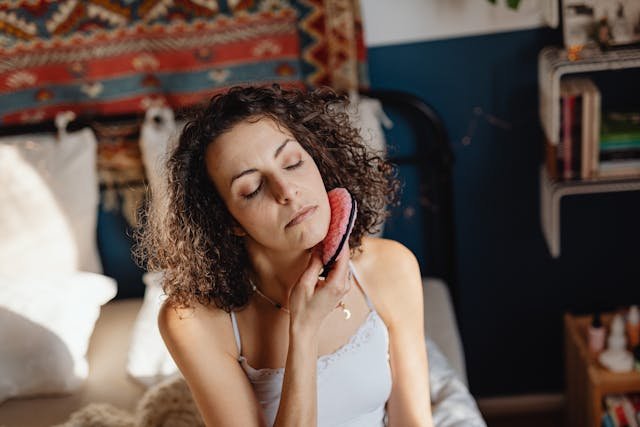
Microneedling has gained popularity as an effective treatment for achieving smoother and healthier skin, providing noticeable improvements with minimal recovery time. However, if you have sensitive skin that reacts to new products, it’s crucial to approach this treatment with caution.
Having sensitive skin doesn’t disqualify you from microneedling; it simply demands a more careful and intentional preparation process. Effectively preparing can enhance both comfort during the procedure and the quality of the results.
Continue reading to discover how to get ready for microneedling if you have sensitive skin, ensuring the best possible outcomes.
Communicate Clearly With Your Provider
Sensitive skin can behave unpredictably during microneedling sessions, making it vital to establish clear expectations with your provider beforehand. Providing detailed information allows them to tailor the treatment to fit your skin’s unique needs.
For a safer and more effective experience, consider bringing up the following points during your consultation:
- Share Your Complete Skin History: Inform your provider about previous treatments, allergies, or past reactions—even minor ones. This information helps identify potential triggers and prevent unexpected irritation.
- Discuss Current Skin Conditions: Mention any ongoing skin issues like acne scars or rosacea directly. These concerns can influence the depth and intensity of the microneedling procedure.
- Inquire About Sensitive Skin Techniques: Some estheticians implement specific methods or settings for delicate skin. Asking ahead of time will help foster trust in their approach.
For optimal results, seek microneedling services in Venice, FL, from a certified esthetician in a state-of-the-art clinical environment. Choose a provider experienced with sensitive skin who customizes treatments accordingly.
Avoid Harsh Skincare Products Beforehand
In the days leading up to your microneedling appointment, prioritize calming and balancing your sensitive skin. Avoid harsh products that can compromise your skin barrier, as this may lead to irritation during or after the treatment.
Here are some products and ingredients to steer clear of before your microneedling session:
- Pause Retinoids and Chemical Exfoliants: Ingredients like retinol, glycolic acid, and salicylic acid can thin the skin’s outer layer, making it more reactive. Cease these products at least 3–5 days prior to preserve your skin’s integrity for treatment.
- Avoid Foaming and Astringent Cleansers: Such products often contain harsh chemicals that strip moisture from the skin. Instead, use a gentle, non-foaming cleanser that maintains your skin’s natural balance.
- Select Alcohol-Free Makeup Removers: High-alcohol content in some removers can dry and sensitize the skin. Opt for an oil-based or micellar cleanser that effectively removes makeup without irritation.
Allowing your skin to rest from aggressive products reduces the chances of irritation, helping it remain calm and better prepared for microneedling.
Hydrate Your Skin Regularly
Adequate hydration is vital for skin health, particularly when preparing for microneedling. Keeping your skin hydrated enhances resilience, minimizing irritation and boosting the treatment’s overall effectiveness.
Consider these key hydration tips:
- Opt for a Barrier-Building Moisturizer: Choose products with ceramides, glycerin, and hyaluronic acid, which strengthen the skin barrier. These ingredients help lock in moisture and create a protective layer, reducing irritation risks during the procedure.
- Moisturize Twice Daily: Regular moisturizing maintains hydration levels, keeping skin smooth and supple. Consistent use prepares your skin to better endure the microneedling process and promotes optimal healing afterward.
- Stay Hydrated: Internal hydration is just as important as topical moisture. Drink plenty of water throughout the day to support skin elasticity and reduce the risk of dryness and irritation during treatment.
By maintaining proper hydration, you create a balanced environment that benefits both the microneedling procedure and the recovery process afterward.

Limit Sun Exposure and Avoid Tanning
Sensitive skin is often more vulnerable to UV damage, so protecting your skin in the lead-up to a microneedling session is essential. Direct sunlight or tanning can heighten the risk of irritation, hyperpigmentation, and may hinder your skin’s healing ability.
Follow these crucial steps:
- Limit Direct Sunlight Exposure: Avoid prolonged sun exposure for at least 3-5 days before your treatment. UV damage can worsen irritation during and after microneedling.
- Skip Tanning Beds and Self-Tanners: These can heighten your skin’s vulnerability to damage and cause uneven pigmentation, increasing sensitivity.
- Wear Sunscreen Daily: Use a mineral sunscreen with SPF 30 or higher, even if you spend most of your time indoors. Shielding your skin from the sun reduces inflammation and fosters quicker recovery post-treatment.
Taking precautions against sun exposure before microneedling helps maintain your skin’s integrity and enhances its ability to heal, leading to optimal results.
Final Thoughts
Microneedling can be a viable option for those with sensitive skin—provided you prepare appropriately. Avoiding harsh ingredients, keeping your skin well-hydrated, protecting from the sun, and collaborating closely with your provider can make a significant difference. By following these steps, you’re setting yourself up to achieve smoother, healthier skin with minimal irritation.






